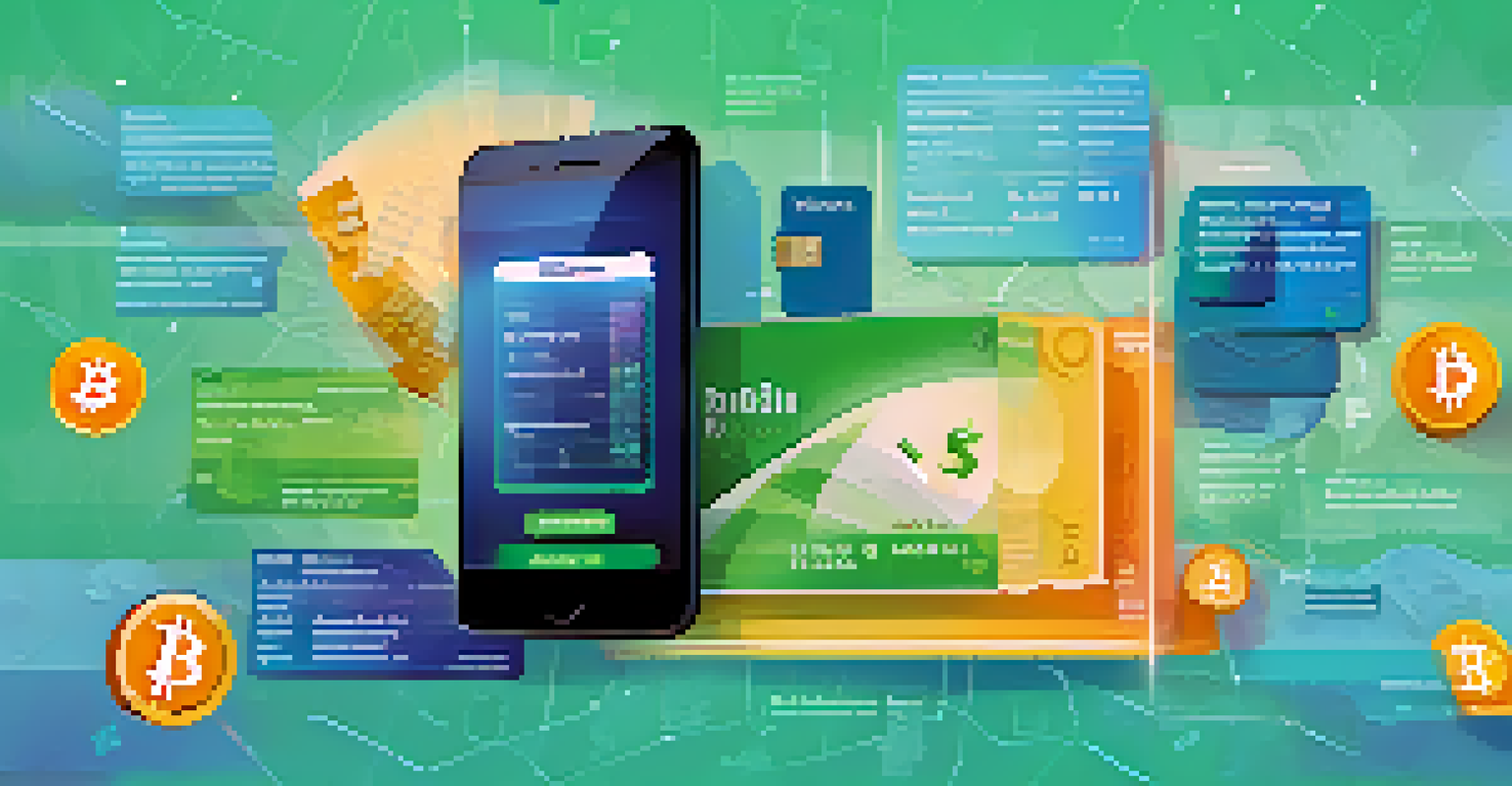Bitcoin as a Medium of Exchange: A Transaction Cost Analysis

Understanding Bitcoin as a Medium of Exchange
Bitcoin, often referred to as digital gold, serves not just as an investment but also a medium of exchange. In simple terms, a medium of exchange is something widely accepted for transactions, allowing people to buy and sell goods or services. Unlike traditional currencies, Bitcoin operates on a decentralized network, which means it isn't controlled by any central authority. This unique characteristic has sparked debates about its viability in everyday transactions.
Bitcoin is a technological tour de force.
To illustrate, think of Bitcoin like a new kind of currency that operates independently of banks. Just as you might use cash or a credit card to make purchases at a store, Bitcoin can be used in similar ways, albeit in the digital realm. Many businesses now accept Bitcoin, allowing customers to pay directly without needing to convert to fiat currency, which can save time and reduce transaction inconveniences.
However, while Bitcoin offers an alternative means of transaction, its acceptance is still growing. Not all vendors are on board yet, and the volatility of Bitcoin's price can make it less appealing for everyday purchases. Understanding these dynamics is crucial when analyzing Bitcoin's role as a medium of exchange.
The Basics of Transaction Costs
Transaction costs refer to the expenses incurred during the process of buying or selling something. These costs can include fees, commissions, and, in the case of Bitcoin, network fees required to process transactions on the blockchain. Understanding these costs is essential for evaluating Bitcoin's efficiency as a medium of exchange. After all, if the costs outweigh the benefits, the transaction may not be worth it.

For example, when you swipe a credit card, you might pay a merchant fee of about 2-3%. In contrast, Bitcoin transaction fees can fluctuate significantly based on network demand. During peak usage times, fees can soar, making small purchases less economical. This volatility can deter people from using Bitcoin for everyday transactions, as they may not want to gamble on potential fees.
Bitcoin's Role as Currency
Bitcoin functions as a medium of exchange, allowing for direct transactions without traditional banking involvement.
Moreover, transaction costs can differ widely depending on the method of payment. While cash transactions might have negligible fees, credit cards and digital wallets can incur costs that add up over time. Therefore, understanding Bitcoin's transaction costs in comparison to traditional payment methods is key to determining its practicality as a medium of exchange.
Bitcoin's Transaction Speed: A Double-Edged Sword
One of the touted advantages of Bitcoin is its potential for fast transactions. Unlike traditional banking systems, which can take days to process international transfers, Bitcoin transactions can occur in minutes. However, this speed can be deceiving due to the complexities of the network. When traffic is high, transactions can be delayed, leading to frustration for users who expect instant gratification.
The future is already here — it's just not very evenly distributed.
Imagine you’re at a coffee shop, ready to pay with Bitcoin. If the network is congested, your transaction may take longer than expected, causing inconvenience. In contrast, cash or card payments are typically instantaneous, allowing for a smoother experience. This unpredictability in transaction speed can be a deterrent for individuals looking for a seamless purchasing experience.
Ultimately, while Bitcoin's potential for quick transactions is appealing, the reality can be more complicated. Users must weigh the benefits of speed against the possible delays caused by network congestion. This balance is crucial when assessing Bitcoin's effectiveness as a medium of exchange.
Volatility: Implications for Everyday Use
Bitcoin's price volatility is one of its most significant drawbacks as a medium of exchange. Imagine using a currency that could lose value overnight; that’s essentially the risk posed by Bitcoin's fluctuating market prices. This volatility can make it challenging for consumers and businesses to price goods and services accurately, leading to uncertainties in transactions.
For example, if a shop lists an item priced at 0.01 Bitcoin, that price could change dramatically before the transaction is completed. This uncertainty can deter businesses from accepting Bitcoin, as they might not want to risk losing potential profits. In contrast, traditional currencies are generally more stable, allowing for predictable pricing.
Transaction Costs Matter
Understanding transaction costs, which can fluctuate significantly, is crucial for evaluating Bitcoin's practicality compared to traditional payment methods.
Thus, while Bitcoin offers an innovative approach to transactions, its volatility poses practical challenges. Users must navigate the risks associated with fluctuating values, which can limit its widespread adoption for everyday purchases.
Security and Trust: Key Considerations
Security is a critical aspect of any medium of exchange, and Bitcoin is no exception. Transactions made on the Bitcoin network are secured through cryptography, making fraud and tampering difficult. However, the decentralized nature of Bitcoin also means that users must take personal responsibility for their digital wallets, which can be a double-edged sword. While this security can be empowering, it also puts the onus on users to protect their assets.
Consider the analogy of a safe: while it keeps your valuables secure, if you lose the key, you’re out of luck. Similarly, if a user loses access to their Bitcoin wallet, recovering those funds can be nearly impossible. This aspect can create anxiety for potential users who might be hesitant to dive into the world of digital currency.
Therefore, while Bitcoin boasts robust security features, it requires users to be vigilant and informed. Building trust in the system and understanding the importance of securing personal wallets is vital for Bitcoin's acceptance as a mainstream medium of exchange.
Comparing Bitcoin to Traditional Payment Methods
When evaluating Bitcoin as a medium of exchange, it’s essential to compare it with traditional payment methods. For instance, credit cards offer consumer protections such as chargebacks, which can provide peace of mind in case of disputes. Bitcoin transactions, however, are irreversible, meaning once a payment is made, it cannot be undone. This can be a significant concern for users who value that safety net.
Additionally, traditional banks often provide customer support to help resolve issues, whereas Bitcoin operates on a peer-to-peer network without a central authority. This lack of customer service can leave users feeling vulnerable if they encounter problems. Therefore, many people may prefer the familiarity and support of traditional payment methods over the uncertainties of Bitcoin.
Volatility Challenges Adoption
Bitcoin's price volatility creates uncertainty for users, making it difficult for businesses and consumers to price transactions accurately.
Ultimately, the choice between Bitcoin and traditional payment methods depends on individual preferences and circumstances. Understanding the strengths and weaknesses of each option is crucial for users when deciding how to conduct their transactions.
Future Prospects: Bitcoin as a Viable Medium of Exchange
As we look toward the future, the question remains: can Bitcoin become a widely accepted medium of exchange? Ongoing developments in technology and regulation may pave the way for broader adoption. For instance, improvements in transaction speeds and fee structures could make Bitcoin more appealing for everyday transactions, helping to address some of the current challenges.
Moreover, as more businesses begin to accept Bitcoin and digital wallets become more user-friendly, public perception may shift. Imagine a world where paying with Bitcoin is as common as using a credit card; this vision could become a reality if the necessary infrastructures are put in place. The growing interest in cryptocurrencies suggests that we may be on the brink of a significant transformation in our financial landscape.

However, challenges still lie ahead. Ensuring stability, security, and user education will be crucial for Bitcoin to cement its role as a practical medium of exchange. The path forward is both exciting and uncertain, making it a dynamic space to watch.